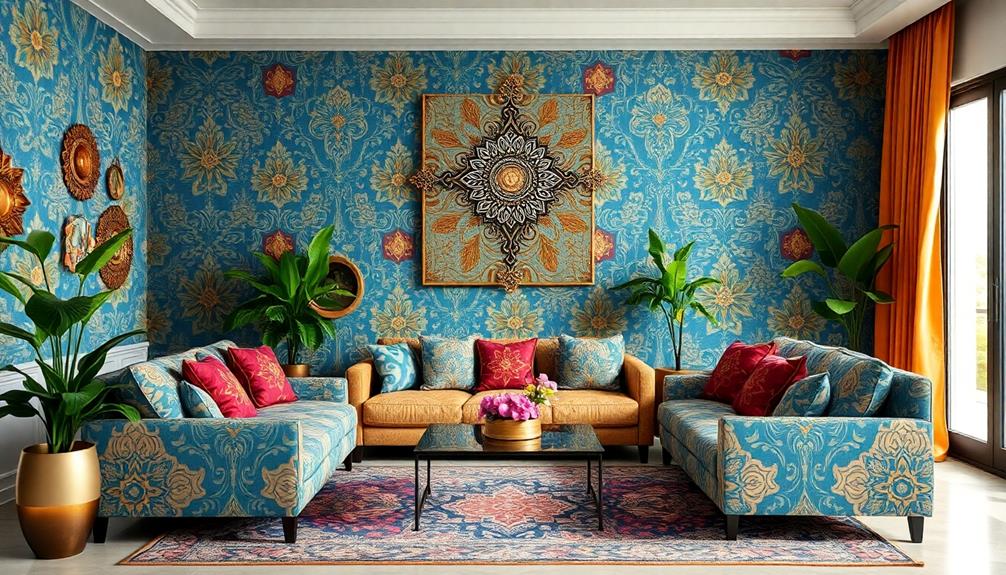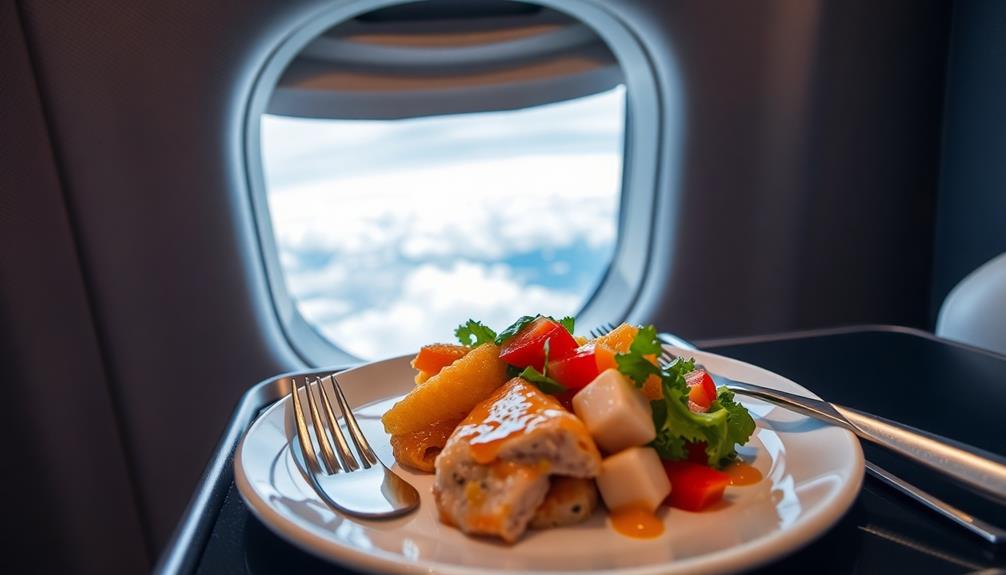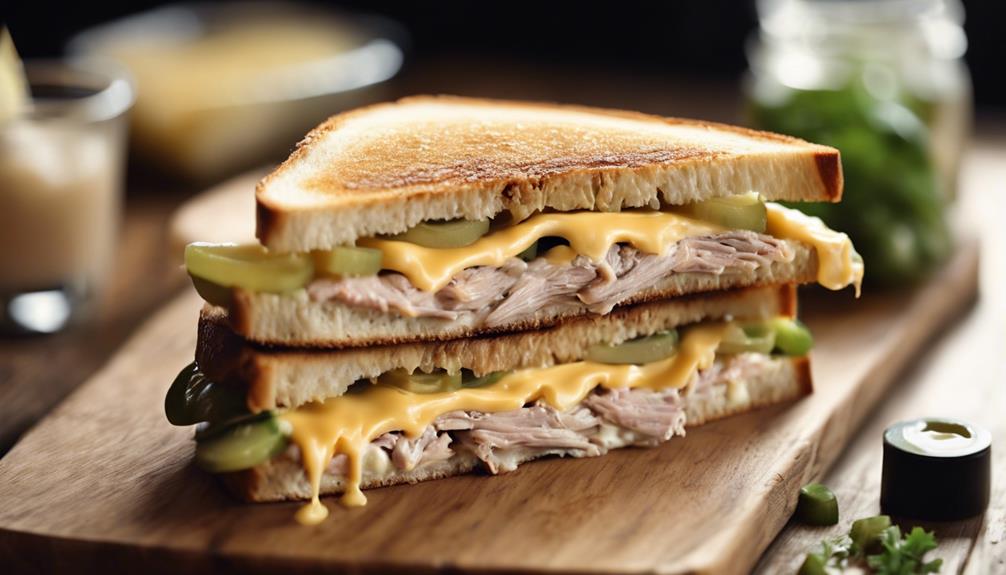The art of food plating goes beyond looks; it greatly impacts your dining experience. When dishes are beautifully presented, they can spark your appetite and evoke emotions. Color plays an essential role, with vibrant hues like red stimulating hunger and greens suggesting freshness. Thoughtful arrangements using techniques like the Rule of Thirds and negative space create visual harmony and excitement. In addition, the shape of the plate influences your perception of portion size and quality. Understanding these elements helps you appreciate meals on a deeper level. There's so much more to explore about how presentation shapes your eating experience.
Key Takeaways
- Food plating enhances visual appeal, stimulating appetite and elevating the overall dining experience through creative presentation techniques.
- Color contrast plays a crucial role, as vibrant hues can evoke emotions and influence perceptions of taste and healthiness.
- Aesthetic principles, such as balance and symmetry, enhance food arrangement, making dishes more inviting and memorable for diners.
- Cultural influences shape plating styles, reflecting traditions and preferences that impact the dining experience across different societies.
- Future trends in plating emphasize sustainability and social media influence, driving demand for visually stunning, health-conscious, and environmentally friendly presentations.
Importance of Food Plating

Food plating isn't just about making dishes look pretty; it plays an essential role in enhancing your dining experience. When you sit down to a beautifully presented dish, like a vibrant plate of Sichuan Cold Noodles that showcases the colors of fresh vegetables and rich chili oil, the food presentation immediately grabs your attention, igniting your appetite.
Research shows that 85% of consumers cite color as a primary reason for their food choices, highlighting the significance of visual appeal. This means the way a dish is plated can directly affect your enjoyment and satisfaction.
Culinary artistry shines through expertly executed plating techniques, conveying a sense of care and skill that elevates your meal. When dishes are aesthetically appealing, you're likely to appreciate them more and may even be willing to pay a premium.
Unique presentation styles can make a restaurant memorable, especially in today's Instagram-driven world, where stunning visuals lead to free advertising and repeat business.
Ultimately, the aesthetic appeal of food enhances your dining experience, fostering mindfulness and encouraging you to savor each bite. By understanding the psychology of food and consumer preferences, chefs can create meals that not only taste great but also look fantastic, ensuring a satisfying experience from start to finish.
Psychological Effects of Presentation

When you see a beautifully plated dish, your appetite often gets sparked by its visual appeal.
The way food is arranged can evoke emotions and influence your perception of quality, making you more likely to enjoy the meal. There is an art and science to plating food in a way that is visually appealing, balanced, and appetizing. Chefs carefully consider color, texture, and proportion as they arrange the elements of a dish to create a feast for the eyes as well as the palate. In fact, research has shown that the presentation of a meal can impact how flavorful and satisfying it is perceived to be, demonstrating the powerful influence of both the art and science of food arrangement.
For instance, a dish like Caldeirada with its vibrant colors and diverse seafood can create an inviting atmosphere.
Understanding these psychological effects can transform your dining experience and elevate how you appreciate each bite.
Visual Appeal and Appetite
A well-plated dish can transform your dining experience, enhancing not just the visual appeal but also your appetite. The way food is presented plays an essential role in your perception of food. Bright colors, like reds, can stimulate hunger, while greens often evoke feelings of freshness and health.
For example, a beautifully arranged plate of Hiyashi Chuka (Cold Ramen) with vibrant toppings can create a revitalizing visual that enhances your desire to eat. Research shows that 85% of consumers consider color a primary reason for purchasing food, highlighting the importance of visual aesthetics in attracting attention.
Color contrast in your meal can notably impact your emotional responses. For instance, red is associated with urgency, drawing your eye and increasing your desire to eat. On the other hand, purple can suggest creativity, enticing you to explore new flavors.
The Mere Exposure Effect also comes into play; as you become familiar with certain flavors and colors, you're likely to develop a preference for visually appealing dishes.
Moreover, variations in food presentation can lead to physiological responses, such as anticipatory salivation. This indicates that visual cues not only enhance aesthetic appeal but also affect your overall enjoyment of a meal, making the dining experience much more satisfying.
Emotional Response to Aesthetics
The impact of food presentation extends beyond mere aesthetics; it profoundly shapes your emotional experience during meals. When you encounter beautifully plated dishes, your emotional response kicks in, greatly influencing your taste perception. For example, dishes like Graveyard Taco Dip creatively combine color and texture, enhancing the overall experience.
Studies show that meals presented with aesthetic appeal are often rated as tastier and healthier. This connection between food plating and your emotions makes a real difference in your dining experiences.
The visual composition and color contrast of a dish can evoke specific feelings. For instance, vibrant reds stimulate hunger, while greens signal freshness and health. This interplay of colors not only enhances the allure of the meal but also makes you feel more excited about it.
Familiarity with visually appealing presentations can lead to a stronger preference for certain foods, thanks to the mere exposure effect.
Moreover, cognitive neuroscience suggests that visual beauty in food can elevate your overall satisfaction while dining. When you appreciate the aesthetics of your meal, it creates a positive emotional response that enhances your experience.
Ultimately, the art of food plating plays an important role in shaping how you perceive and enjoy your meals, making aesthetics an essential aspect of your culinary journey.
Perception of Quality and Value
Research shows that 30% of how you perceive a meal's quality and value hinges on its presentation. When you see a beautifully plated dish, it instantly elevates your food perception. The aesthetic appeal—like plate design and color contrast—can transform a simple meal into a gourmet experience.
For instance, a dish like Agnolotti can be enhanced with thoughtful garnishes, making it visually stunning and more appetizing. You mightn't realize it, but vibrant colors and thoughtful arrangements can make you feel like you're enjoying something truly special.
Studies indicate that 69% of millennials photograph their food before digging in, underscoring how visual elements impact your dining experiences. High-quality dinnerware also plays a significant role; meals served on elegant plates are often rated higher in taste and overall satisfaction. This connection between plate design and perceived value can't be overlooked.
Furthermore, the Mere Exposure Effect suggests that the more you encounter visually appealing dishes, the more you tend to like them. Over time, this familiarity can enhance your perception of their quality.
Embracing the art of food plating not only enhances your meal but also enriches your overall dining experience, making every bite feel more valuable.
Aesthetic Principles in Plating

When you plate your dishes, think about visual balance techniques like the Rule of Thirds to guide the arrangement of food components.
Incorporating color contrast not only makes your plate pop but also enhances appetite appeal, so don't shy away from using vibrant colors.
For instance, when serving dishes like Mushroom Masala, the rich blend of spices can be beautifully complemented by garnishing with fresh coriander, adding both color and freshness to the presentation.
Visual Balance Techniques
Achieving visual balance in food plating transforms a meal into an artful experience. To create this balance, apply the Rule of Thirds by arranging your main components along imaginary grid lines. This method guides the eye and enhances the overall visual appeal.
Incorporating negative space—leaving parts of the plate bare—highlights key elements, fostering a sense of elegance and focus. For instance, a dish like Nettle and Potato Soup can be plated with a swirl of cream, creating a striking visual against the vibrant green soup.
Adding dimension to the plate is vital; layering ingredients and varying their heights not only creates visual intrigue but also enhances the perception of abundance. Maintaining symmetry can evoke harmony, while using odd numbers of elements can introduce a dynamic, balanced visual appeal.
Don't forget about color contrast, as it plays an important role in stimulating appetite and drawing attention. Bright, contrasting colors can evoke emotional responses and enhance perceived freshness, making your dish even more inviting.
Color Contrast Importance
Color contrast plays an essential role in food plating, greatly enhancing the visual appeal of your dishes while stimulating appetite. When you choose the right color of the plate, it can markedly affect the perception of the food you present.
For example, vibrant colors like reds and yellows can evoke feelings of hunger, while greens often signal freshness and healthiness, directly impacting consumer preferences. Consider how a festive presentation of dishes like Graveyard Taco Dip can further elevate the dining experience, making it more engaging and enjoyable.
By effectively using color contrast, you create a visual hierarchy that guides attention to key components of the meal. A dish presented on a contrasting color plate not only looks aesthetically pleasing but also enhances the perceived quality and value of the food.
Research shows that diners are more willing to pay for meals that are visually appealing, underscoring the importance of thoughtful plating.
Incorporating a variety of colors helps to make your dish stand out. As you plate your food, consider how the colors interact and the emotions they evoke, ensuring that your presentation not only looks good but also makes an enticing statement about the flavors to come.
Color and Its Influence

The vibrant hues of a dish can markedly impact your dining experience, as studies reveal that 85% of consumers consider color a key factor in their food choices. Color plays a significant role in enhancing the appeal of the dish, influencing your perception of taste and even your appetite. Bright colors like red stimulate hunger, while greens evoke freshness and health, making your meal visually irresistible.
For instance, the vibrant colors of Chilaquiles: A Mouthwatering Mexican Dish can enhance its appeal and stimulate appetite even further.
When you plate your food, pay attention to color contrast. A beautiful plate that showcases a variety of shades can elevate the visual aesthetics of your culinary creation. Research indicates that the color saturation of your dish can even alter taste perception; for instance, salty foods served in blue bowls are often rated as sweeter.
This cross-modal sensory interaction demonstrates how sight can influence flavor appreciation.
Incorporating a cohesive color palette not only enhances the overall appeal of the dish but also creates a multi-sensory experience that boosts dining satisfaction. By thoughtfully considering the colors you use, you can transform your food into an enchanting feast for the eyes and palate alike.
The Role of Plate Shape

Plate shape considerably influences how we perceive our meals, impacting everything from portion sizes to taste perceptions.
For instance, when serving traditional dishes like Horiatiko Psomi, the choice of plate can enhance the rustic charm of the bread, making the meal feel more inviting. You mightn't realize it, but the plate you choose can enhance the visual appeal and overall dining experience.
Here are three key ways plate shape affects your meal:
- Portion Sizes: Round plates often highlight food, making portions appear larger. In contrast, a larger plate can make food seem smaller, potentially leading to overeating due to the Delboeuf Illusion.
- Taste Perceptions: Research shows that round plates can evoke sweeter taste perceptions, while black plates elevate the perceived quality of the food served.
- Arrangement of Food Components: Unique or elongated plates encourage creative designs that promote linear presentations, enhancing the aesthetic appeal of your dish.
Cultural Perspectives on Plating

Cultural perspectives on plating reveal the rich tapestry of traditions and values that shape how we present food. Your cultural background greatly influences your plating methods. For instance, collectivistic societies often embrace conservative presentation styles, emphasizing a communal dining experience. In contrast, individualistic cultures may focus on more elaborate visual aesthetics.
Take Indian cuisine, which showcases authentic serving vessels and traditional plating methods that celebrate its rich heritage. Japanese plating, on the other hand, emphasizes simplicity and balance, reflecting minimalist aesthetics.
You'll notice how French cuisine has evolved, integrating modern techniques inspired by social media and global culinary trends to create stunning presentations.
Seasonal themes also play an essential role in how you choose ingredients and design your menu, with monochromatic plating often favored for its sophistication and harmonious balance.
Additionally, you'll see a rise in deconstructed forms of traditional dishes across various cuisines, highlighting a blend of cultural heritage with contemporary culinary creativity. These diverse approaches to plating not only enhance the dining experience but also connect you to the rich cultural stories behind each dish.
Future Trends in Food Plating

How will the future of food plating evolve in a world driven by visual appeal and innovation? As you navigate this landscape, expect to see several key trends shaping the art of plating:
- Social Media Influence: With platforms like Instagram dictating trends, chefs will focus on creating visually stunning plates that are shareable. The aesthetics of food elements will play an important role in driving engagement.
- Technology Integration: Augmented reality and interactive features will enhance your dining experience, allowing you to engage with your food in new ways. Imagine a dish that tells a story about its ingredients as you eat!
- Sustainability Focus: Chefs will increasingly use eco-friendly plating techniques, prioritizing locally sourced and seasonal ingredients. This not only minimizes waste but also appeals to environmentally conscious diners looking to showcase their culinary values.
As these trends develop, you'll see dishes that not only please the palate but also highlight health, culture, and sustainability, reflecting a different aesthetic and a global culinary influence.
Embrace these changes, as they'll redefine your dining experiences in exciting ways!
Frequently Asked Questions
What Is the Psychology of Plating Food?
The psychology of plating food involves how presentation influences your perception of taste. Colors, simplicity, and strategic arrangement can enhance your appetite, making you appreciate the meal more and potentially increasing your overall satisfaction.
What Is Food Plating Aesthetics?
Food plating aesthetics focuses on the visual arrangement of your dish, enhancing its appeal. By using color, balance, and simplicity, you create an inviting presentation that influences how others perceive taste and value.
What Is the Philosophy of Plating?
Like a painter on canvas, you arrange food to create visual beauty and enhance flavor. The philosophy of plating focuses on balance and harmony, transforming dining into an immersive experience that stirs emotions and satisfies senses.
What Are the 5 Basic Elements of Plating?
When you plate food, focus on color, balance, negative space, height, and garnishing. These elements create visual appeal, enhance flavor, and elevate the overall dining experience, making each dish more enticing and enjoyable for you.
Conclusion
In the end, mastering the art of food plating isn't just about making a dish look pretty; it's about creating an experience that tantalizes both the eyes and the palate. When you plate food with intention, you're inviting your guests to savor not just a meal, but a moment. So, why settle for ordinary when you can elevate your culinary creations into extraordinary works of art? After all, you eat with your eyes first—make it count!









